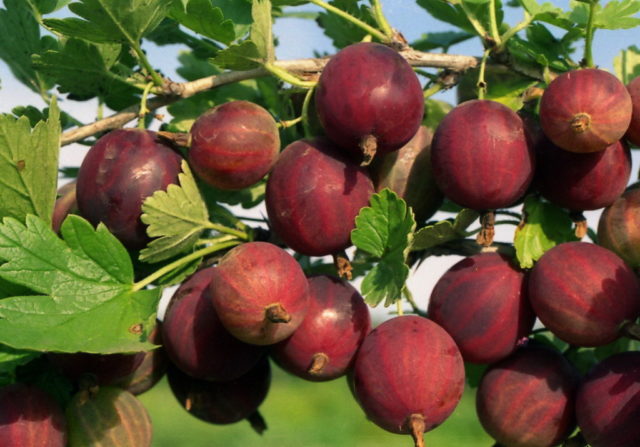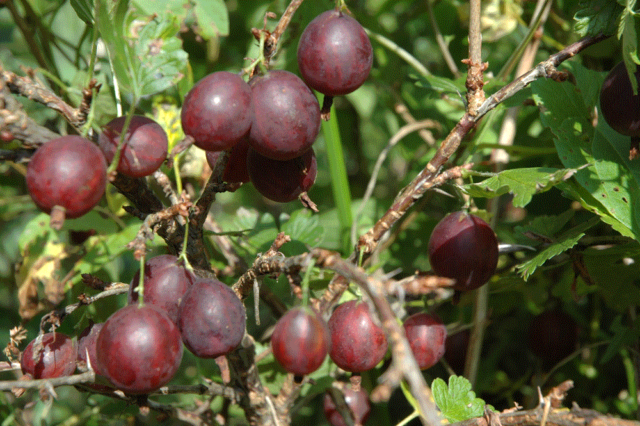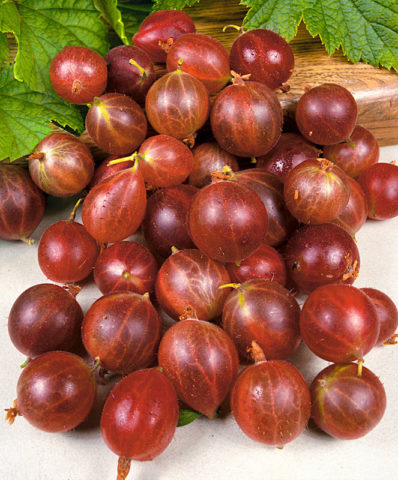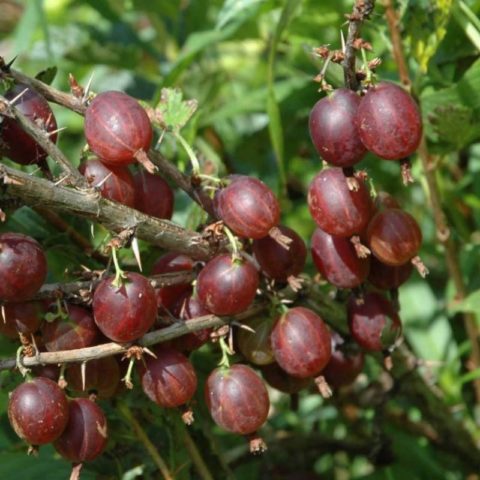Content
Gooseberry Olavi, or Hinnonomainen Punainen, is a high-yielding Finnish berry variety characterized by a pleasant fruit flavor, resistance to parasites and ease of growing. Due to its high frost resistance, the culture feels great even in the harsh climatic conditions of the northern and northwestern regions of Russia. However, before purchasing a gooseberry popular among gardeners, it is worth studying its characteristics, strengths and weaknesses, planting and care features in order to achieve the maximum yield of the variety.
Olavi gooseberry description
Olavi gooseberries (a description of the variety and photos are given below) has been included in the State Register of Breeding Achievements since 1999. The shrub is approved for cultivation in the Vologda, Tver, Yaroslavl, Kostroma, Kaliningrad, Pskov, Leningrad, Novgorod, Murmansk and Arkhangelsk regions of Russia. Promising for cultivation throughout the Non-Black Earth Zone. It is considered a versatile mid-late culture.
Olavi has the following characteristics:
- Bush shape. Slightly spreading, medium height.
- Shoots. Of medium thickness, upright, not pubescent, green in color. After lignification, they can turn gray.
- The degree of studding of the branches is strong. Spines are single and bipartite, sharp, of medium length and short. They are located along the entire branch and are directed perpendicular to it.
- Kidneys. Pointed, small, elongated, slightly deviated.
- The leaf blade is medium in size, non-pubescent, slightly shiny, saturated green, divided into 3-5 lobes with large teeth along the edges. Attaches to the shoot obliquely with a short cuttings.
- The flowers are broadly bell-shaped, of medium size.
- Fruits are medium-sized, weighing about 3.7 g (2.0-4.4 g), rich cherry color, hairless, oval and rounded, covered with a waxy bloom.
The Olavi variety is considered a highly self-fertile crop (about 50%) and does not need pollinators.
Drought resistance, frost resistance
The Olavi variety was specially created for cultivation in areas with long frosty winters and short summers. The culture can safely withstand up to - 30 ⁰С.
The Olavi variety has average resistance to droughts. Long-term lack of moisture negatively affects the berries. Gooseberry fruits grow small, sluggish and sour in taste. The leaf plates of the shrub turn yellow and slow down growth.
Fruiting, productivity
Olavi berries are characterized by:
- juicy sweet and sour pulp (tasters estimate - 4.5);
- almost complete absence of aroma;
- refreshing taste;
- thin skin;
- high productivity (up to 13 kg per bush);
- mid-late ripening (from mid-August to the very frost);
- good keeping quality and transportability.
The chemical composition of Olavi gooseberries in terms of sugar content is within 5.9-11.9%, and in terms of acidity - 2.5-3.6%. The amount of ascorbic acid per 100 g of fruits of this variety is 20-39 mg.
Olavi berries are used to make original jam, marmalades, aromatic compote. The fruits are also suitable for fresh consumption.
Advantages and disadvantages
Gardeners consider the advantages of the Olavi gooseberry variety:
- high winter hardiness;
- stable fruiting (up to 20 years);
- immunity to most diseases;
- versatility and pleasant taste of the fruit;
- pest resistance;
- long shelf life without losing weight gooseberries;
- quick survival of seedlings.
The disadvantages of the Olavi variety are called a large number of thorns on the shoots and the possibility of fruit cracking in rainy weather.
Breeding features
Olavi gooseberries are mainly propagated vegetatively.
To obtain cuttings in early May, a 2-year-old healthy shoot is placed in a moistened planting furrow and sprinkled with earth. Periodically, the soil is watered and hilled. By the fall, several shoots are formed, ready for transplantation.
The grafting method has a lower survival rate, but is used when it is necessary to quickly obtain a large amount of planting material. In early June, 15-centimeter cuttings are cut from green shoots, after which they are planted under a film. To stimulate the growth of the gooseberry root system, the soil is periodically moistened.
Planting and leaving
Olavi gooseberries prefer sunny, draft-proof places for planting. An ideal option is considered to be a site on a hill with protection from the cold wind in the form of a fence or walls of a building.
The soil for Olavi gooseberries is chosen fertile, from sandy loam to clay. The main thing is that there is no swampiness, the Olavi variety does not tolerate the close location of aquifers.
The dates for planting gooseberries depend on climatic conditions. In the northern regions, the Olavi variety is planted in the spring, after the soil has warmed up enough, but the buds have not yet had time to open. In areas with a warmer climate, an autumn planting of crops is carried out (in October).
Before planting, the root system of Olavi bushes is soaked for a day in a solution of sodium guamate or "Barrier". The procedure contributes to the quick survival of gooseberries in a new place.
The very planting of Olavi gooseberries is carried out in several stages:
- Dig a planting hole with a depth and diameter of no more than 0.5 m.
- Fill it up to half with loosened earth. Mix the soil with 1 bucket of humus, 4 tbsp. l. nitrophoska and 1 tbsp. ash.
- Place a seedling in the hole at a right angle.
- Spread the gooseberry roots and compact the soil.
- The bush is watered abundantly.
- Extra shoots are removed, while leaving 6 living buds.
- The ground is mulched with peat.
Growing rules
The Olavi gooseberry variety, despite the simplicity of cultivation, requires timely implementation of agrotechnical procedures.
During the dry period, gooseberries are regularly watered with settled warm water, at least 1 time in 10 days. It is especially important to irrigate during flowering and during the period of fruit formation. The surface crust formed after watering is loosened, and the weeds are removed. The gooseberry trunk circle is mulched.
Until the age of 3 years, the Olavi shrub is periodically carried out formative pruning. The procedure consists in cutting off the skeletal shoots of the gooseberry to ½ the length and removing almost all the shoots.
In an adult gooseberry, the pruning procedure is carried out to reduce the density of the shrub and facilitate harvesting.So, after the end of winter, weak or damaged shoots are removed on the culture, while leaving about 16 shoots of different ages.
Olavi reacts favorably to feeding. During the season, the procedure is carried out 3 times (the proportions are given for 1 plant):
- before the leaves appear - with urea (2 tablespoons per 1 bucket of water);
- during flowering (1 tbsp. l potassium sulfate per 10 liters of water);
- when fruiting (2 tbsp. l. nitrophoska per 10 liters of water or potassium sulfate, as before).
To protect the Olavi variety from pests, twice a year, the aisles of the shrub are dug up to a depth of 15 cm, and the near-trunk circles are loosened deeper than usual (up to 8 cm). In preparation for the winter period, in order to prevent the development of diseases and the appearance of pests, gooseberries are treated with a 1% solution of Bordeaux liquid.
The Olavi variety does not need shelter for the winter. To ensure the safety of the root system of an adult shrub, they spud the earth around the plant, and sawdust or dry peat are poured into the gooseberry tree trunk. Young crops are covered with non-woven fabrics.
Pests and diseases
Olavi gooseberries rarely get sick. Fungal infection usually affects the culture in conditions of high humidity and low temperatures. In this case, the fruits of the shrub are covered with a dense gray film. To eliminate the problem, use "Topaz" or "Oxyh".
Of the pests on Olavi shrubs, aphids are the most common. To combat it, the culture is sprayed with a solution of ordinary laundry soap and anthills are removed from the site.
Conclusion
Olavi gooseberries do not require special cultivation techniques, but at the same time they are distinguished by high productivity and excellent fruit taste. And such qualities as frost resistance, resistance to diseases and pests, ease of reproduction, make the culture a welcome guest on personal plots of different regions of the country.
Olavi gooseberry reviews














